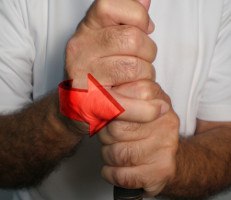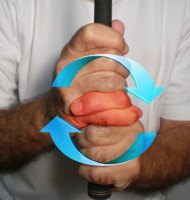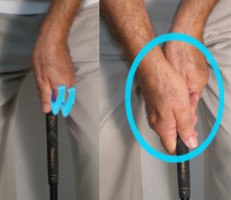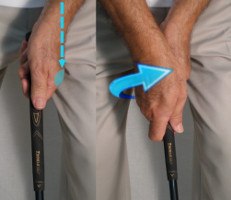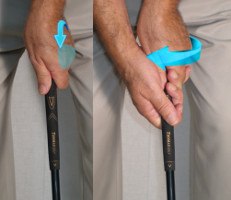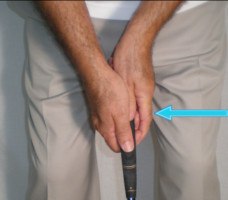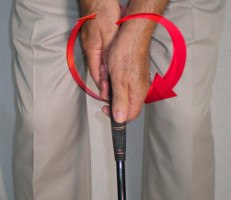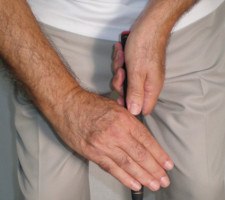Pros and Cons of Every Golf Grip Style |
Best Grip? Overlapping vs Interlocking |
- Overlapping grip
- Best for strong, flexible players
- Easy to adapt to
- Increased stability and comfort
- More feel of the club head
- Harder to control
- Distance may be limited
- Must be used precisely or small flawed habits may result
- Interlocking grip
- Best for players with smaller hands
- Helps weaker players strengthen their grip on the club
- Encourages both hands working together
- Can grip the club looser
- Can be difficult to get your fingers in a comfortable position
- Can produce a pull if not in the right position
- Less feel of the club head
- Causes pain in joints if used incorrectly
- 10 finger/Baseball grip
- Good for beginners, seniors and ladies
- Creates better leverage
- Hands are not locked together-promotes a “handsy” swing
- Easy to understand the science of this grip
- Very repeatable
- Hands are not locked together-promotes a “handsy” swing
- Easy to snap hook if you overswing
- Wrists can get “flippy” if not used properly
There are three basic variations of the golf grip; overlapping, or Vardon grip, interlocking and ten finger or baseball grip. See below some information on each grip that might help you understand why they may or may not work for you.

Pros of using this grip
Cons of using this grip
This grip was popularized by Harry Vardon during the early part of the 20th century. The main feature of the Vardon grip is the overlapping of the right pinkie finger over the left index finger, usually resting in the groove between the left index finger and left middle finger. The gripping action of the right pinkie finger helps to keep the two hands to help them work as one. Some golfers prefer to rest the right pinkie finger over the top of the left index finger, rather than nestled in the groove between the left index and middle fingers, and that personal grip choice is a perfectly acceptable Vardon grip variant. The benefits of the overlapping grip: are stability, comfort, and easy to adapt to. Authors’ note…I have found that putting the right pinkie finger in the groove between the index and middle finger of the left hand can cause some discomfort. The disadvantages: harder to control the club during the swing, minor flaws have consequences on results, may limit distance. Most professional golfers use the overlapping grip; players such as Ben Hogan, Phil Mickelson, and Adam Scott.
Jordan Spieth actually uses a variation of this grip that can best be described as a “reverse overlap” grip. The pinkie finger of his right hand does not rest in between the index and middle finger of the left hand as in the standard Vardon grip. Instead, the left index finger stretches over top of the right hand and partially interlocks with the right pinkie finger. Some suggest that this peculiar grip, coupled with a somewhat weak left hand helps Spieth to move the ball in both directions with ease.
Pros of using this grip
Cons of using this grip
The pinky finger of the right hand hooks (or dovetails) around the forefinger of the left hand. This forms a physical connection that pulls the two hands tightly together. When hands using this grip wrap around a club’s cushioned grip, the result is an extremely strong “joint.” This physical strength is the big attraction of an interlocking grip, and its advantages manifest themselves in a variety of ways. They also suggest that this grip is good for creating unity, natural strength and a player with small hands.
Pros of using this grip
Cons of using this grip
The Baseball grip, sometimes called the ten finger grip, is preferred by beginners. Many golf instructors recommend a baseball grip for children, senior golfers or female golfers. The better leverage achieved helps players to develop their swing with less frustration. They suggest that all golfers should avoid using a baseball grip. Authors’ note…I have used this grip all of my life. Although many of the things experts say about this grip are true, I have found it to be extremely comfortable and easy to use my hands more. This may not appeal to everyone, but it works for me. One of the advantages of the baseball grip is that it is easy to duplicate and simple to understand. As a beginner, the baseball grip might be a good place to start. The other are that benefits from the use of this grip is your short game. With the hands working separate from each other, many touch/feel shots are possible to perform.
There are many variations of each of these grips, but the truth is that 99% of golfers in the world will use one of these grip styles. Each one has its own merits and flaws. There is no hard and fast rule as to which might be best for you. What is known for sure is that the way you grip the golf club is the single most important factor in how your golf swing will progress. I would recommend that you experiment with each grip (even the baseball grip) to some degree. Eventually you will find one that works best for you.
